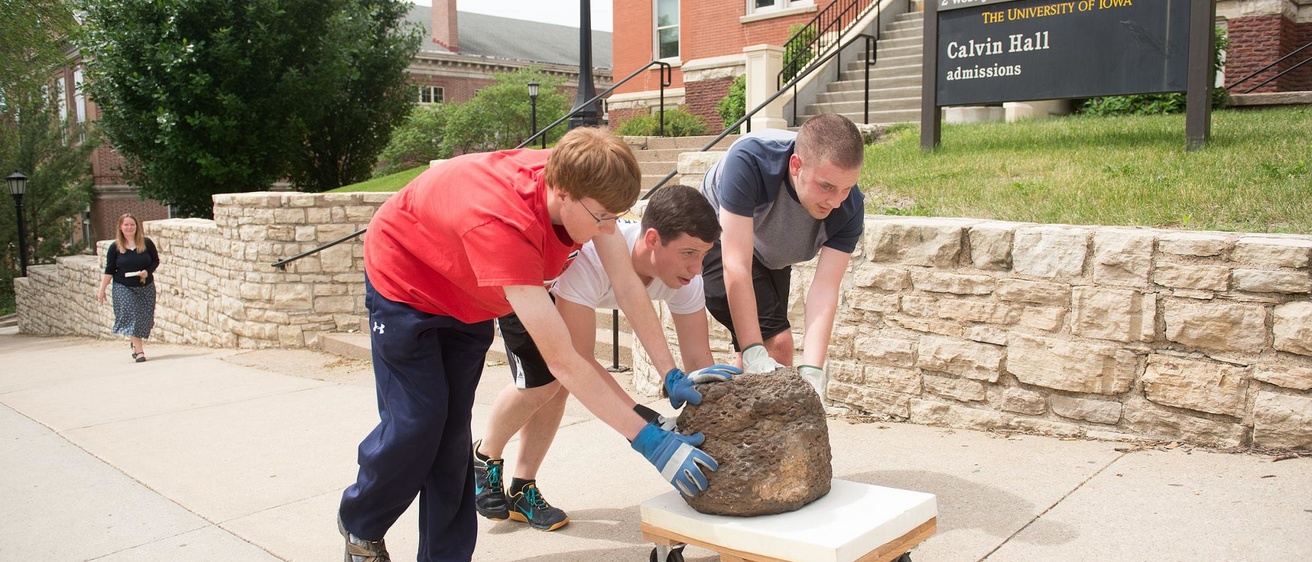In a windowless room on the second floor of Trowbridge Hall is the most complete record of Iowa’s geological past.
There, tucked away in floor-to-ceiling drawers and spilling into the aisles, is the University of Iowa’s fossil collection, an amalgam of more than 1 million plant and animal specimens dating from about 500 million years ago to the near-present.
“Behind these doors is a history of life in Iowa,” says Tiffany Adrain, collections manager at the UI’s Paleontology Repository.
That history is getting a major makeover. Adrain is overseeing the digitization of the UI’s collection. The goal is to make the fossils more accessible to researchers and to the public by making each specimen available online for all to see. The university also is moving fossils long stored in the basement of Calvin Hall (and most recently in Halsey Hall) to Trowbridge in order to centralize the collection, some of which will be housed in Trowbridge’s basement.
UI’s fossil collection, by the numbers
More than 1 million specimens—20,000 plant specimens, the rest animal (mostly marine)
Specimens come from Iowa, at least 44 states in the U.S., and 78 foreign countries
Marine invertebrate collection is one of the 10 largest university collections in North America, according to research published in The Paleontological Society Special Publications
About 500 specimens of mammals that lived in the Pleistocene epoch (which includes the most recent ice age)
Students and volunteers have put in 3,480 hours in the past year alone to digitize the collection
“Our collection is not in the 100-year scale. We’re in the forever scale,” says Adrain, adding that she wants to raise awareness about the collection and its value to Iowans.
There is plenty to check out:
- Marine life (both plant and animal) from the Ordovician Period, beginning 488 million years ago, when Iowa was a warm, shallow sea located near the equator
- Primitive fish and corals from the Upper Devonian Period (about 375 million years ago), the period best represented in the UI’s fossil collection and illustrated with a standalone display at the UI Museum of Natural History
- Five-hundred-pound petrified tree stumps and “coal balls” (plant material that didn't turn into coal) from about 300 million years ago
- Mammals from the ice age, including woolly mammoth bones and giant ground sloth remains found in southwest Iowa
The university hosts field trips so Iowa school children can view and interact with the fossils, and highlights from the collection have been featured in the UI Mobile Museum, which tours the state. Periodically, high school students in the Iowa City area will volunteer to work for a week at a time.
Adrain has cobbled together multiple grants—from the U.S. National Science Foundation, the Paleontology Society, the Iowa Science Foundation, the State Historical Society of Iowa, and the UI—to digitize the collection. The money has enabled her to hire a team of students to take photos of individual specimens, identify them when necessary, and catalog them online.

It’s no simple undertaking—especially considering the UI’s marine invertebrate (animals with no backbones) collection alone is one of the 10 largest university assemblages of its kind in North America. Many fossils are tiny, which makes photography tricky. Others have labels that either have deteriorated or have been eaten by pests, making identification challenging. And there’s the sheer volume of specimens waiting to be digitized.
Maja Stina Sunleaf is cataloging 3,000 vials, bags, and slides of Quaternary Period fossil pollen, plant, and animal remains found by Richard Baker, professor emeritus in the UI Department of Earth and Environmental Sciences. Sunleaf, a junior from Dubuque majoring in anthropology, says what she’s learned from caring for and handling fossils should help her in her summer job at the Field Museum in Chicago.
“I absolutely adore museum work, and working in the UI Paleontology Repository has further proven that I want to work with collections in the future,” Sunleaf says.
Kent Isaacson has been driving from Waterloo since August to clean and wrap ancient corals for shipment to the Smithsonian Museum in Washington, D.C. The University of Northern Iowa graduate says he volunteered because he wants to be a preparer in a museum. Sometimes as he works, he thinks about what the world must have been like so many years ago.
“It’s kind of mind boggling how old the Earth is,” says Isaacson, who will pursue a master’s degree in geosciences at Fort Hays State University in Kansas. “It kind of puts it all in perspective.”
The UI collection started in 1855, when it was called the UI Cabinet of Natural History and housed material gathered during geological surveys of Iowa. Its scope has expanded and includes specimens gathered in the late 1800s by UI geology legends Thomas Macbride and Samuel Calvin and, more recently, corals collected in the Caribbean by retired professor Ann Budd.
There are also new species, including trilobites (ancient distant cousins of horseshoe crabs) from the Great Basin area in Nevada and Utah found and collected by UI paleontologist Jonathan Adrain.
The museum lends fossils to researchers in other countries and accepts specimens that will enhance the collection from researchers worldwide.
Adrain, who serves as collections manager and who came to Iowa after working for a decade at the Natural History Museum in London, illustrates this by showing drawers full of tiny eel-like conodonts donated by the former Amoco oil corporation.
“Our specimens go around the world and come to the collection from around the world,” he says.
